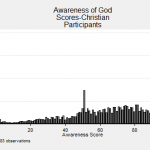I have been reading the sociological literature on race and religion, especially multiracial churches. A common observation is that Christian churches are relatively segregated by race and ethnicity. Different scholars have different estimates of the segregation, and it depends on how it’s measured. Among the statistics I’ve read: an estimated 90% of American Congregations draw at least 90% of their members from a single racial group and only about 8% of churches fit the description of multiracial.
In reading studies of integrated churches, I am struck by how very, very difficult it is to have multiple racial and ethnic groups in one church.
There are distinct advantages to demographic homogeneity (fancy work for saying that people are similar to one another). In fact, some churches explicitly tailor their outreach to specific “types” of people, and this approach often associates with specific racial or ethnic groups. Emerson and Smith (2000) likened it to retail stores aiming for a specific market—clothes for teens, kitchen supplies for the wealthy, electronic gizmos for middle-aged men. People often want to be in a church with others like them—they felt more readily understood, so this approach is effective.
When churches do seek racial integration, it can bear substantial costs. Among the possible costs that scholars have identified:
- Churches feel like they are losing their identity
- Churches have less feeling of group solidarity
- Worship services are reworked
- Decision making processes are changed
- New staff are hired
- Services and materials are offered in multiple languages
- Communication, both verbal and non-verbal, is frequently misinterpreted
- Conflict arises in church about the smallest of issues. (One study told of a race-related row about where to place a statue)
- Food service at fellowship events are changed
- Length and style of sermons are changed
- And on and on and on
One pastor exclaimed that multiracial ministry is simply exhausting, and this seems to be true in terms of time, energy, and material resources.
While some church growth specialists have argued in favor of a homogenous ministry outreach, most Christians (myself included) seem to be in favor of racially integrated community life. My point here is not to advocate racial integration as much as to be aware of the significant difficulties of accomplishing it.














